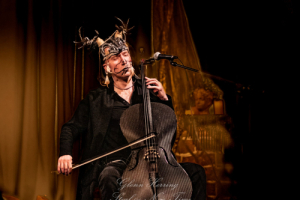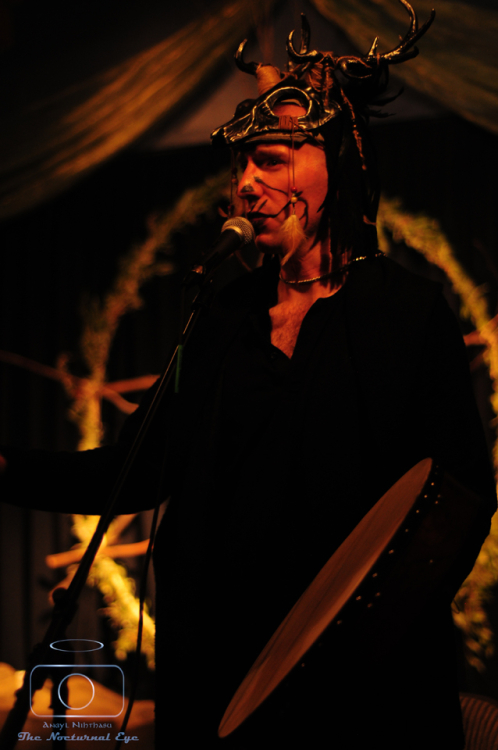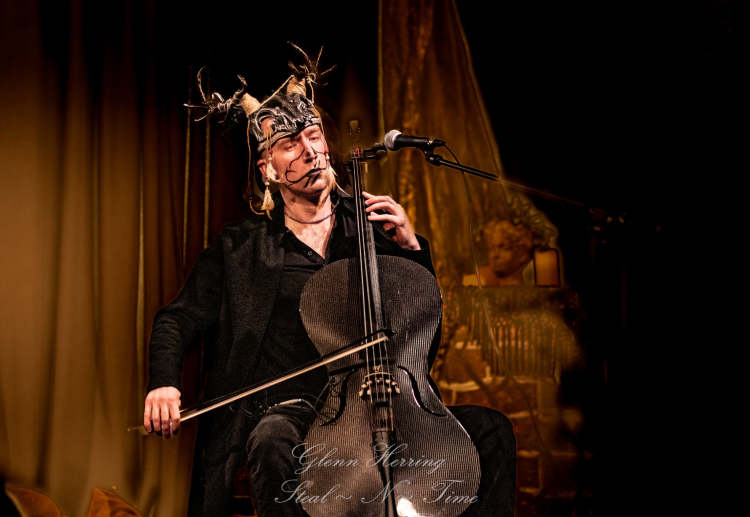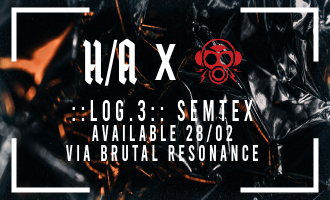
Hello Gremnir and welcome to Brutal Resonance! We’ve covered you a few times before but this is the first where we’re speaking…Or typing to one another. Let’s start with the basics. Gimme three of your favorite albums of all time and tell me why you like them so much.
Thank you so much for having me! I love this music magazine and seeing so many unique artists getting attention here. Talk about a difficult question. For artists I’ve found in the last few years the first would have to be “Lifa” from Heilung. It’s a wonderful live acoustic album that captures the visceral spirit of musical rituals honoring the old gods. Second would be “Slør,” by Eivør Pálsdóttir. She has such a divine, powerful, and versatile voice that hooked me with her track “Mjorkaflokar.” If the blossoming rays of sunlight over a dew-kissed hilltop at dawn had a sound, it would be that track. Third would have to be Myrkur’s “Folkesange.” When it comes to acoustic albums that take the listener back in time and inspire movement, Amalie Bruun (the composer and lead singer) knows what she’s doing. The opening piece “Ella” is my personal favorite on that album. Powerful stuff.
You’re a Nordic Folk artist with a dedication to paganism. Tell me how you discovered paganism, how it spoke to you, and how it’s helped guide you through life.
Great question! Admittedly it’s a pretty fresh path for me, having only started in 2020 just before the COVID-19 Pandemic hit. Prior to then I’d been an outspoken atheist. I’d begun a history binge after learning some about my heritage and looked in greater detail about the Nordic stories from Viking age Scandinavia, getting as close to the source material as I could by finding some scholars on the topic and cross-referencing their writings. Dr. Jackson Crawford is one such scholar and has gotten remarkably popular with his YouTube channel by teaching/speaking different reconstructions of Old Norse, diving into detail about stories and poetry from that era. He keeps up with new discoveries in that vein too and offers commentary. I highly recommend him for curious people who want to get veritable information from trusted specialists.
The more I read about these stories, the gods and how human they were I found them to be compellingly relatable. They aren’t perfect and don’t pretend to be as such. With that realization it opened my eyes to many pantheons I’d read about in the past (Greek, Egyptian, Irish, to name a few), and how closely they were tied to aspects of human and environmental nature. I found myself wanting to learn and recite all of Odin’s 200+ names from memory (still working on that) and reaching out to people across the globe to find out what it really means to be pagan. The more I learned, the more I believed in the gods. Moreover, if I am to believe in one pantheon I must acknowledge and believe in all others to respect the cultures outside my own. It makes logical sense to me to follow that. This opened my mind to animism as well: first and foremost seeing nature as sacred, that everything has a spirit that connects to and affects everything else around it. Animism also implies that all of the gods live inside all of us, that we are divine beings connected to everything and everyone. Because of that we need to value empathy and interpersonal connection, sharing respect and respecting ourselves, too.
In short, paganism and animism has helped me better understand and connect with myself, my environment, and human beings.
As far as instruments go, you seem to do it all. What drew you to more archaic forms of music making in comparison to modern?
Thank you for that sentiment! All the instruments you hear in my music are my cello Obsi∂ious and bodhrán Irish frame drum Membross, with vocal accompaniment and/or body percussion (striking different parts of my body with my hands to make a sound).
I suppose the archaic sound is something that ties to my background in cello performance, since I started playing it just before high school and was obsessed with Baroque music for a few years. Orchestral music had a lot warmer, inviting and expressive qualities than much of the big-hair 80’s rock and 90’s pop music I grew up listening to. These old masters I studied were the titans of Western music, starting with Vivaldi and Bach, and slightly further back in time to more obscure composers like Monteverdi and Hildegard von Bingen among countless others. Learning about traditional instruments and aural songs passed down through time really drew me in, hearing these raw, organic sounds from several centuries ago reaching new generations in the 21st century. That, and traditional instruments being used to make new music. It’s like listening to echoes of history. Thank goodness for the Internet in this way.

Gremnir just recently started, or so it seems, with the 2019 self-titled album. What was your goal with this initial release? Did you want it to break out or was it more of a challenge for yourself, to prove that you could do this?
A part of me hoped it would take off. In college I’d written for chamber ensembles, string orchestras and symphony orchestras, and even got my own symphony performed at my graduate recital in 2016. It made sense to me to try something in the complete opposite direction to challenge myself, and it did. At its core making the album was really a test of my own abilities for what I could do sonically on my own and perform it in live settings. I wanted to explore dark storytelling in a solo acoustic setting, whether with my cello or drum, and be able to do it simply like a troubadour, skald or bard in the European medieval and renaissance eras.
Now, I have a question about one of the songs on your debut. ‘Rushles von Egglesmaff’. While every other song seems to have a darker root, ‘Rushles von Egglesmaff’ sounds more like something a bard would be singing in a D&D inspired setting. How does this fit in with the theme of the album?
‘Rushles’ is one of the more popular tracks from that album! A lot of the people I’ve met at open mics enjoy it. You’re right, it does sound cartoony, and that’s part of the more grim point. ‘Gremnir’ as an album explores the peaks and valleys of dark storytelling, so this story about an insane goblin king named Rushles and how he implicitly gave up everything he loved to make an instrument for his malicious patron god fits pretty well. The playful song setting I think helps with the piece’s unsettling character. You may also be right in it being used by a nondescript singer in a D&D campaign!
Your next single was ‘Of Demons and Goddesses’. This is an almost eleven-minute single. A whole saga is told within the track. How do you come up with your lyrics and verse?
Well, this saga is an original story—of the same title—modeled on Ancient Greek tragedies. It started as a written story which was later turned into a song to perform. The lyrics were challenging, as the story for me was too intricate to be jammed into a 3-5 minute piece and it didn’t seem right to break it up into multiple songs. As someone new to singing and home recording at the time, I was figuring out what my voice was capable of. All that said, the story’s arch is somber with bits of anticipation, hope and implicit love between two characters of near polar-opposite nature. A complex situation arises with nothing but damning outcomes, and one of the characters helps the other in the way truest to who they are. The result: scorn.
Then came ‘Sultr’, another single with an emphasis on throat singing. Is this something that you had to practice much or did it just come naturally to you?
Throat singing is a tricky art form involving nuanced control over the mouth shape, tongue and false folds in the throat. I had to figure it out after watching so many fascinating videos of multicultural people around the globe do it. Such a gorgeous, powerful and dynamic sound that comes from the voice. Unfortunately none of the tutorials online were helpful in figuring out how to do it, so after much trial and error what worked for me was growling and singing at the same time. Ta-da!

You then released your album “Broken”. What was the overall theme of this album? The Bandcamp page reads under the description, “Two halves to the mind ever struggle toward synthesis.” What does that mean to you?
“Broken” was written and recorded over the course of the COVID-19 Pandemic. Between working as a remote music teacher and having prolonged bouts of existential dread it gave me a lot of time to reflect on who I am, what I want and what I value. This album was written with self-reflection in mind, more specifically learning to acknowledge our subconscious darker half (or ‘shadow,’ in Jungian terms) within us and embrace it on our quest to become more beautiful and whole. The phrase you mention, to me, means that we as humans are ever-evolving to find balance within ourselves.
I’d been listening to music from Heilung, Eivør, Wardruna, Nytt Land, Faun, Danheim, Myrkur, Trobar De Morte and many others in the Nordic Folk genre and wanted to apply what I’d sonically learned from them and make an album with this concept at the fore. The album includes some stanzas of poetry from an Old Norse poem “Grógaldr,” or “Groa’s Spells,” which is about a young man who suspects he’s being plotted against by his betrothed. Desperate for help he summons the ghost of his mother, Groa, who sends him protective incantations to ward off any foul play being cast at him. These stanzas can be heard across the tracks ‘Galdr I-IV.’
‘Galdr I - Invocation’ is the musical ritual that prepares listeners for our journey inward, chanting seven protective spells to guide us to safe passage in embracing our darkness. ‘Galdr II - Meditation’ is the journey to delve into our own personal hell, to face the things that wait for us there and embrace the puppeteer of it all: our shadow. The visual description listeners will hear is modeled after two experiences I had several years ago in my own meditations. ‘Galdr III - Integration’ is the unification of light and dark: Mind to mind, spirit to spirit. Their joining reforges the self with new strength and beauty; inner dissonance wrought to resonance. ‘Galdr IV - Declaration’ is our new self now strengthened after having conquered our inner demons. Others’ voices join in solidarity and a mighty force gathers under thunderous drums marching steadily, ready to take on the world.
‘Sinnsyk’ was your next single. I remember discussing this one with you through e-mail; it has a very sincere backstory to it. What is it?
This piece is dedicated to my grandfather Max, who was my father figure and with whom I was very close. He and my grandmother looked after me for many years from grade school through high school summers. We also went on a few memorable road trips together, including Yellowstone National Park and visited family members in the southern US. It is for and about all of us who have lost loved ones, for us who have grieved deeply, who have loved fully.
SINNSYK’s first title was “Mild Insanity (2006)” for solo cello and the first piece of music I ever wrote (it can be heard on my album ‘Gremnir’). ‘SINNSYK’ is Norwegian for ‘insane,’ which is a callback to its original working title. While heavily instrumental the Norwegian lyrics paint a picture of a young man who visits his ancestor’s grave. From there he finds a song for them from Hel and casts it after their spirit with his voice and stringed instrument. There is a music video of SINNSYK available to watch on my YouTube channel from March 2023.
Lastly, you have your latest single ‘Two Wolves’. You partnered with Heather Evans on this single. Who is she and how did she elevate the song?
Heather is a dear friend and business consultant of mine. We met just a few months before COVID hit and got to know each other much better about halfway through it with our consultations. She’s a skilled and prolific singer-songwriter based in Ohio who has been helping me get a foot into the door of sync licensing: she’s landed some good placements in shows like Teen Mom, First Kill, So You Think You Can Dance, and several others. She’s been leaning into her darker aspect of songwriting for sync and is working with a lot of talented people. Most importantly Heather is a very considerate, kind and overall wonderful person to have as a friend!
We wrote this song, and from my home studio I recorded all of the parts save for hers. She has a rich voice that I knew could carry the role of the gentle Wise Wolf in this piece, contrasted to the growly and deep Wild Wolf that I act as. To my pleasant surprise her singing added haunting and ethereal elements that turned the song’s quality up a few notches, sent a shiver down my spine when I first heard her voice in the project.
What else have you planned for 2023 that you can tell us about?
Right now I’m focused on getting my third album recorded, of which ‘SINNSYK’ and ‘Two Wolves’ are included and will be released around September 2023. Where ‘Broken’ conceptually was built on looking inward to find strength in self using some Old Norse poetry, this one is more focused on finding strength in others and solidarity for a strong support system. To help deliver this message I’m singing verses from the poem “Hávamál,” or “Odin’s Teachings”: Old Norse text from Viking-age Scandinavia. There is a lot of universally practical wisdom from this book, and the parts I’m using involve treating our healthy relationships with dignity and respect, mutual gift-giving and enforcing boundaries. As much as Odin is a bloodthirsty and scheming war-god he understands the value of having mutually fruitful and sustainable relationships, tending the gardens of fellowship and solidarity.
A big reason why I’m using these Hávamál passages is to combat the rapidly divisive social and political climate as fascism spreads in the United States. White supremacists have been trying (and failing) since the mid 1870’s to appropriate Norse mythology, symbology and culture into their murderous ideology as it has gotten wildly popular in the last two decades. There’s literally no evidence to support their bigoted claims that these stories support their beliefs, and this project is part of my mission to prove that they are trying to climb a rootless and rotted tree. Nazis will never own a piece of Scandinavian history and culture, nor any other.
Lastly, I’d like to thank you for your time. The space below is free for you to mention anything I may have missed.
Thank you so much for having me and for the thoughtful questions! I’ll be planning an album release show in the San Francisco Bay Area later this year. Until then folks can keep up with me through Instagram and TikTok. If fellow music makers like my work, I record everything from my home studio and offer remote recording services through Soundbetter.

Steven Gullotta
info@brutalresonance.comI've been writing for Brutal Resonance since November of 2012 and now serve as the editor-in-chief. I love the dark electronic underground and usually have too much to listen to at once but I love it. I am also an editor at Aggressive Deprivation, a digital/physical magazine since March of 2016. I support the scene as much as I can from my humble laptop.
Share this interview
Facebook
Twitter
Google+
Shares
Popular interviews
Psyclon Nine
Interview, Mar 24 2017
Night Runner
Interview, Oct 13 2016
Testube
Interview, Apr 02 2022
Kite
Interview, Feb 10 2017
God Destruction
Interview, May 17 2016
Related articles
Gremnir - 'Sinnsyk'
Review, Nov 28 2022
Gremnir - 'Sandr Ok Snjár (feat. Naheli and Suvi)'
Review, Sep 03 2023
Gremnir - 'Two Wolves (feat. Heather Evans)'
Review, May 31 2023
Gremnir - 'Broken'
Review, Jun 06 2022
Joy Shannon & the Beauty Marks - 'The Oracle'
Review, Nov 11 2013



